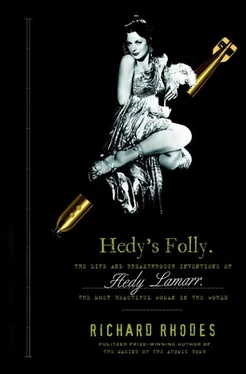Richard Rhodes
HEDY’S FOLLY
The Life and Breakthrough Inventions of Hedy Lamarr, the Most Beautiful Woman in the World
A grant from the Alfred P. Sloan Foundation supported the research for this book.

( illustration credit fm.1 fm.1 MGM/Robert Coburn, 1938 i1.1 © John Springer Collection/CORBIS i1.2 Collection of An Pham, www.hedy-lamarr.org . Used with permission of Denise Loder-DeLuca i1.3 © 2010 Richard Rhodes i1.4 Moviepix/John Kobal Foundation/Getty Images i1.5 Courtesy of Filmarchiv Austria. Used with permission of Thomas Sessler Verlag i1.6 © Time & Life Pictures/Getty Images i1.7 Courtesy of Hirtenberger AG, from the Hirtenberger AG Anniversary Publication, 2010 i1.8 Used with permission of Denise Loder-DeLuca i1.9 © 2010 Richard Rhodes i1.10 Courtesy of the Estate of George Antheil i1.11 © Bettmann/CORBIS i1.12 Courtesy of the Estate of George Antheil i1.13 Courtesy of the New York Public Library Performing Arts Research Collections, American Music Collection. Used with permission of the Estate of George Antheil i1.14 © CORBIS i1.15 Courtesy of Popular Mechanics ( popularmechanics.com ). Originally published in the August 1938 issue i1.16 AP Photo i1.17 Courtesy of the Estate of George Antheil i1.18 Photo by Shlomo Sonnenfeld i1.19 © Horace Bristol/CORBIS i1.20 United States Patent Office, Patent #2292387 i1.21 AP Photo i1.22 Used with permission from Stars and Stripes , © 1945, 2011 Stars and Stripes i1.23 ESA/P. Carril i1.24 mptvimages.com
)

[INTRODUCTION]
Hedy Lamarr, Inventor
Invention is a strange business. Is it creative, like painting or sculpture? It’s certainly original, by definition genuinely new, but it’s also and fundamentally practical. Patent law says an idea must be “reduced to practice” to be patentable. That means an idea must be embodied in some new and useful mechanism or process or material. So invention is creative, but not in the same way the fine arts are. Usefulness isn’t fundamental to a sculpture or a painting.
Is invention, then, scientific? Many inventions today are explicitly derived from scientific discoveries. The discovery that certain materials, stimulated in a particular way, would emit coherent light—light all of the same wavelength—led to the invention of the laser. The laser was a practical device that embodied the discovery, but it wasn’t the discovery itself. The distinction is clear even in prescientific times: Fire was a discovery; the fireplace was an invention. That fire hardened clay was a discovery; pottery was an invention. Again, as with fine art, usefulness isn’t a requirement for scientific discovery.
That invention is different from fine art or scientific discovery suggests that inventors might be different from artists or scientists. They are. Many inventors are technically trained, of course, especially those who invent professionally. Thomas Edison was home- and self-educated, but Nikola Tesla, the inventor of radio, was an electrical engineer. Some inventors have been artists. Samuel F. B. Morse, the co-inventor of the telegraph, was a professional painter. The same person might do science and invent. I knew such a person, a Nobel laureate American physicist named Luis Alvarez. Luis’s many inventions won him a place in the National Inventors Hall of Fame. He told me once that he valued his recognition as an inventor more than the Nobel.
But many inventors, past and present, have been people with no obvious special qualifications for inventing. Come to think of it, there are no special qualifications for inventing. No school I know of offers such a degree. As a sculptor is someone who sculpts, as a writer is someone who writes, an inventor is someone who invents.
The 1940s Austrian-American movie star Hedy Lamarr was an inventor. The public-relations department at Metro-Goldwyn-Mayer, where Hedy began her American film career, put out the claim that she was “the most beautiful woman in the world,” and by Western standards she may have been. It annoyed her deeply, however, that few people saw beyond her beauty to her intelligence. “Any girl can be glamorous,” she famously and acidly said. “All you have to do is stand still and look stupid.”
Hedy invented as a hobby. Since she made two or three movies a year, each one taking about a month to shoot, she had spare time to fill. She didn’t drink and she didn’t like to party, so she took up inventing. When she was a girl, her father, a Viennese banker, had encouraged her interest in how the world worked, taking walks with her and explaining the mechanics of the machinery they encountered. As a young woman, before she emigrated from Austria to the United States, she married a munitions manufacturer and listened in on the technical discussions he held with his Austrian and German military clients. She also had a keen sense of the world’s large and small failings, some of which she decided she could fix. In Hollywood she set up an inventor’s corner in the drawing room of her house, complete with a drafting table and lamp and all the necessary drafting tools.
Hedy conceived of her most important invention in 1941, in the dark years between the German invasion of Poland in September 1939 and the Japanese attack on Pearl Harbor in December 1941 that finally impelled the United States to enter the war. She wanted to help her newly adopted country (where she was still technically an enemy alien) and saw the need for a weapon to attack the German submarines that were devastating North Atlantic shipping. It’s characteristic of her confidence in her inventive gift that she believed she could devise such a weapon and help change the course of the war. Her belief was folly in two senses of that fine old word: extravagant in consequential invention, and founded on the foolish notion that the United States Navy would take correction from a Hollywood actress of great beauty in a matter about which it was not prepared to listen to its own submarine commanders.
Her unlikely, but ideal, partner in that work was an avant-garde composer and concert pianist named George Antheil, at five feet four a “cello-sized man,” as Time magazine put it, a New Jersey native whose father owned a shoe store. Antheil was not, like Hedy, an amateur inventor, but he was nearly polymathic in his gifts. When Hedy revealed her idea to him, he immediately saw a way to give it practical form for the purpose of patenting it.
That practical form linked back to Antheil’s most notorious composition, a twenty-minute rhythmic cacophony of grand pianos, electric bells, drums, xylophones, a siren, a gong, an airplane propeller, and sixteen synchronized player pianos called Ballet mécanique , which premiered in Paris in 1926. In his Paris days, before he moved to Hollywood to make a living writing film scores, Antheil was a good friend of Ernest Hemingway, Igor Stravinsky, the bookseller Sylvia Beach (the Antheils lived for ten years in a small apartment on the mezzanine of Beach’s famous Shakespeare and Company bookstore), James Joyce, Ezra Pound, and most of the rest of the fabled crowd of expatriates who helped make Paris a world center of art, music, and literature in the years between the two world wars.
Hedy in Vienna, George in Paris, and then the two of them meeting up in Hollywood to invent a fundamental new wireless technology makes a remarkable story at the center of Hedy Lamarr’s long and fascinating life. Except in the matter of her beauty, which she valued least of all, people regularly underestimated her. She deserved better. The real story will amaze you.
Читать дальше














